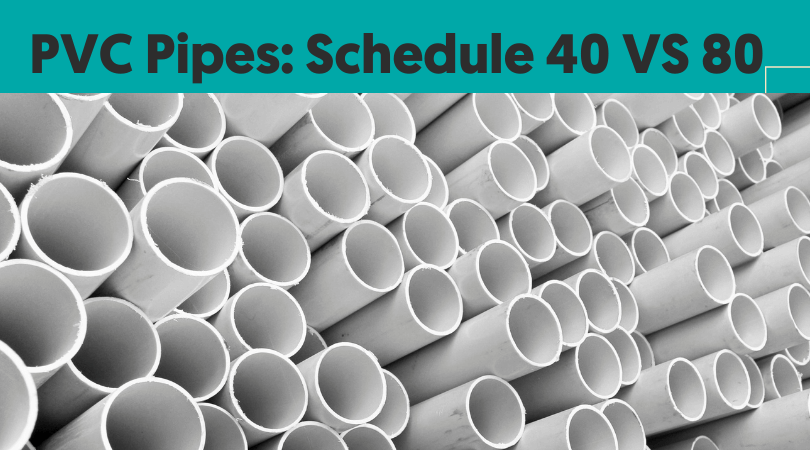Hello, people. I will share a well-researched guide on schedule 40 vs 80 PVC pipes. Everything you need to know about them is mentioned in this piece.
Schedule 40 VS Schedule 80: PVC Pipes
Pipe scheduling can be a rigorous task, that is, if you don’t know what to do. Although scheduling is essential to pumping, most people falter because they don’t even understand what scheduling is. Scheduling in piping has nothing to do with the human concept of timetable or time management; instead, it’s a measurement pattern. For example, scheduling a fabrication mechanism utilized to figure out a plumbing material’s total wall thickness depending on the full size of the pipe (including width, not length).
In laymen’s terms, a pipe schedule is a typical standard for how thick a pipe’s wall should be established upon how wide/large the pipe is in diameter.
You might have noticed that the outside diameter of Schedule 40 pipes and 80 pipes are the same, but 80 pipe has thicker walls; thus, schedule 80 pipes are a bit more expensive than their 40 counterparts. The Scheduling system came into the picture as a standard of measuring as there was a need to have a universal system for referring to PVC.
Since different wall thicknesses are used in other applications, the ASTM Society developed the Schedule 40 and 80 systems to categorize the two common groups.
Comparison: Schedule 40 VS 80 Pipes
- Thickness
- Pressure
- Cost
- Color
- Installation
- NPS and Outer, Inner Diameter
- Durability
- Visibility
- Temperature resistance
- Chemical Resistance
- Application and Use
- End Type
Interesting Read – CPVC VS PVC | Difference Between PVC and CPVC
Thickness
Pipe wall thickness is the fundamental physical difference between Schedule 40 and Schedule 80. The higher the schedule rating, the thicker the pipes and fitting. As a result, schedule 40 will have thinner walls than Schedule 80 in the same specified size. That means less material equals a weaker product, which in turn can hamper its project’s compatibility if the solidarity of the pipe is in the question of the desired application.
Higher schedule pipes that are thicker will have higher structural and chemical durability and rigidity to strain, pressure, and harsh environmental conditions.
Pressure
A pipe’s maximum PSI pressure rating can be determined by its scheduling. Pipes and firings with higher Schedule numbers are better for pressure handling. Their higher tolerance for continuous fluid pressure results from increased material thickness specified by the pipe schedule.
Generally, 80 is a more reliable choice for a high-pressurized liquid application schedule. However, Schedule 40 can also be utilized if the application pressure ranges are within the piping’s guidelines. Refer to the table below about Schedule 40 and 80 sizes, dimensions, and working pressure.
Cost
Not surprisingly, Schedule 80 pipes are expensive compared to Schedule 40 pipes because of the additional material used to make their sidewall thicker. In addition, any included colorant (if applicable) can also zip the overall manufacturing cost.
Color
Schedule 40 and 80 pipes are often colored with different colors to give them a distinct identity. Sch 40 plumbing pipes are naturally white, lacking coloring additives; however, Schedule 80 pipes are colored grey. Note that following that color pattern is not mandatory, and outliers to the norm also exist.
While color is a reliable way to identify which type of pipe you’re dealing with, remain cautious and always go through printed labels on the side of the pipes.
Installation
The installation process and parameters are identical for Schedule 40/80 pipes made from the same material. According to ASTM standards, outside diameters will be equal across lines with similar NPS schedules. This provision allows pipes of different scheduling to be joined together using the normal fitting method for that piping material.
NPS and Outer, Inner Diameter
The Normal Pipe Size (NPS) measurements for Sch 40 and 80 piping will be the same for the same pipe size. NPS is similar to pipe Outer Diameter (OD) measurement, which will be the same for schedule 40 and 80 pipes. What differs between the two is the Inner Diameter (ID) measurements. In Sch 80, the ID increases significantly because of the extra material used to make its sidewalls on the inside thicker. The reduced inner diameter of the Sch 80 pipe makes the fluid flow a bit slower.
Durability
Schedule 40: While durable for many applications, its thinner walls make it less robust than Schedule 80.
Schedule 80: The increased wall thickness protects against physical damage and long-term wear.
Visibility
Schedule 80’s darker color and thicker walls make it less transparent than Schedule 40 PVC. If you need to see the liquid flow (like in certain laboratory setups), Schedule 40 might be preferred.
Temperature Resistance
Given the increased wall thickness of Schedule 80 pipes, they often have a higher temperature resistance than Schedule 40 pipes. This can be crucial in applications where the material will be exposed to elevated temperatures.
Chemical Resistance
Both PVC types offer good chemical resistance, but because of the thicker wall, Schedule 80 might offer slightly better protection in environments with corrosive chemicals.
Applications and Use
If you’re planning a home repair or an irrigation project, Sch 40 is the definitive choice. Even Schedule 40 pipes can handle a lot of pressure, making them more than adequate for home applications, and it is cheaper than Sch 80; it won’t be hard on your wallet.
However, Schedule 40 pipes aren’t the best choice if your application includes moving industrial chemicals. Go for Schedule 80 with thicker sidewalls, and you’ll be fine. These pipes can handle high pressure and stress.
End Type
Both Schedule 40 and Schedule 80 PVC pipes can come with different end types, such as plain end or belled end, but this is more about the application and less about the difference between the two schedules.
Schedule 40 vs. 80 is all about that. Piping applications are particular, and only after detailed examination and analysis can one determine what needs to be done. Full variables of the pipe’s intended use should be considered for the best results.
Engaging Read – What are PVC Pipe Sizes? | What are PVC Pipe Dimensions? | The Complete Guide
Difference Between Schedule 40 and 80: PVC and CPVC Properties
| Nominal Pipe Size (NPS) | Outside Diameter (OD) | Schedule 40 Wall Thickness | Maximum Pressure (PSI) | Schedule 80 Wall Thickness |
Maximum Pressure (PSI)
|
| 1/8″ | 0.405 | 0.068 | 810 | 0.095 | 1230 |
| 1/4 | 0.54 | 0.088 | 780 | 0.119 | 1130 |
| 3/8 | 0.675 | 0.091 | 620 | 0.126 | 920 |
| 1/2 | 0.84 | 0.109 | 600 | 0.147 | 850 |
| 3/4 | 1.05 | 0.113 | 480 | 0.154 | 690 |
| 1 | 1.315 | 0.133 | 450 | 0.179 | 630 |
| 1 1/4 | 1.66 | 0.14 | 370 | 0.191 | 520 |
| 1 1/2 | 1.9 | 0.145 | 330 | 0.2 | 470 |
| 2 | 2.375 | 0.154 | 280 | 0.218 | 400 |
| 2 1/2 | 2.875 | 0.203 | 300 | 0.276 | 420 |
| 3 | 3.5 | 0.216 | 260 | 0.3 | 370 |
| 3 1/2 | 4 | 0.226 | 240 | 0.318 | 350 |
| 4 | 4.5 | 0.237 | 220 | 0.337 | 320 |
| 5 | 5.563 | 0.258 | 190 | 0.375 | 290 |
| 6 | 6.625 | 0.28 | 180 | 0.432 | 280 |
| 8 | 8.625 | 0.322 | 160 | 0.5 | 250 |
| 10 | 10.75 | 0.365 | 140 | 0.593 | 230 |
| 12 | 12.75 | 0.406 | 130 | 0.687 | 230 |
| 14 | 14 | 0.437 | 130 | 0.75 | 220 |
| 16 | 16 | 0.5 | 130 | 0.843 | 220 |
| 18 | 18 | 0.562 | 130 | 0.937 | 220 |
| 20 | 20 | 0.593 | 120 | 1.031 | 220 |
| 24 | 24 | 0.687 | 120 | 1.218 | 210 |
How to Apply Scheduling to Determine Pipe Sizes and Dimensions?
When discussing the intricacies of pipeline installation and management, the significance of pipe scheduling is often undervalued. This method is paramount for construction companies, engineering teams, plumbing professionals, and installation experts. Essentially, a pipe schedule serves as an insightful guide to ascertain a pipe’s adaptability and aptness for its designated role.
In the assessment and procurement phase of plumbing components, specialists meticulously select the pipe dimensions and the corresponding schedule rating.
This ensures the chosen pipes can comfortably fulfill, if not surpass, the requirements of the targeted application. For those not steeped in industry jargon, think of pipe scheduling as a compass guiding you toward the most fitting plumbing solutions.
Achieving optimal outcomes in various plumbing contexts mandates thoroughly examining factors like pipe robustness, permissible pressure thresholds, compatibility with certain chemicals, and overall expenditure. These considerations are intrinsically tied to the pipe schedule classifications.
FAQs

Below are the frequently asked questions on PVC schedule 40 vs 80. Let’s dig deep to learn more
What is the standard length of a PVC pipe?
All types of PVC pipes sold are 10 feet to 20 feet long. Plain end (square-cut) or bell-end.
Is PVC cheaper than wood?
PVC and other composites are high-performance products and often cost more than wood deckings. Wood deckings vary depending on the application, but PVC is still significantly more expensive than wood.
Are PVC pipes UV resistant?
UV light radiations cause the outer part of the PVC pipe to show color variations. However, the color change is meager and doesn’t leave long-lasting damage to the pipe. The visible color change is called UV discoloration.
Long-term and continuous exposure to sunlight can decrease the pipe’s impact strength and resistance; however, it doesn’t impact the pipes’ pressure resistance capabilities, malleability, and rigidity. Interestingly, furniture-grade PVC pipes are UV resistant and don’t exhibit any effect of sunlight.
What is the life expectancy of PVC pipes?
The life expectancy of all PVC pipes is up to 75 to 100 years.
Can CPVC catch fire?
PVC material is not considered flammable. PVC has an ignition temperature of 734 degrees Fahrenheit (390 degrees Celsius) to catch fire. Even if it catches fire, the spread will be very slow.
Suggested Read
- Top 5 Heat Resistant Plastic Materials | A List of High Temp Plastic Materials
- Polycarbonate Vs. Acrylic | What are the Differences and Similarities?
- Plastics Vs. Polymers | What are the Differences?
- Step Growth vs Chain Growth Polymerization
The Conclusion
To sum up, for plumbing, construction, and various applications, PVC Schedule 40 and PVC Schedule 80 are conventional PVC pipes. Although both are made from the same material, their properties differ significantly.
PVC Schedule 80 is thicker, stronger, and more durable than Schedule 40, making it ideal for high-pressure and outdoor use, albeit more expensive. Selecting either schedule would ultimately rely on the application’s requirements and available budget.
Thanks for reading. Kindly share your reviews in the comment section.
Have a wonderful day.
Quick Navigation



You’re such a good writer and explainer.
Thanks